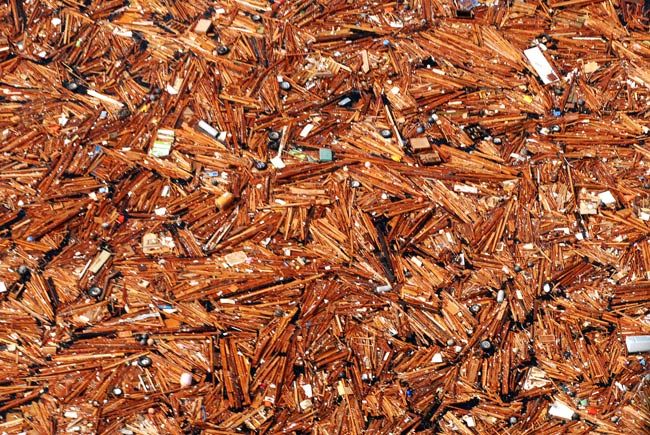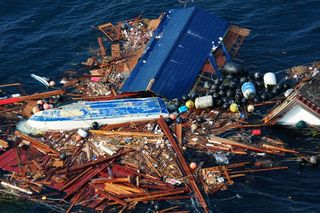
Japan Tsunami Debris Expected on U.S. Shores in 3 Years

The powerful earthquake and ensuing deadly tsunami that struck Japan on March 11 produced now-familiar scenes of devastation — entire villages and towns reduced to rubble.
Once the waters receded, they took scenes of the devastation with them. Piles of debris — smashed homes, cars, boats, and perhaps more grim reminders of the lives lost in the tsunami — are now afloat in the Pacific Ocean, born on powerful currents, and are predicted to hit the United States, according to a model developed by researchers at the University of Hawaii. [Related: Japan Earthquake and Tsunami in Pictures.]
Roughly a year from now, the first wave of debris is expected to hit Hawaii's Midway Islands. In two years, the debris cloud will likely hit Hawaii's main islands, and in three years, it's projected to arrive on the U.S. West Coast, said Jan Hafner, a scientific programmer who helped develop the model at the university's International Pacific Research Center in Honolulu.
Wreckage from Japan could hit shorelines from Baja, Calif., as far north as Alaska.
However, Hafner told OurAmazingPlanet, the debris is then expected to head back out to sea and wallop Hawaii again, in a second, more powerful wave.

"The main cloud of the debris would turn to the southwest and end up in the Pacific Garbage Patch, and within five years it will be coming out of the garbage patch once in a while and hit Hawaii over and over and over," Hafner said.
The Great Pacific Garbage Patch — known to scientists as the North Pacific Subtropical Convergence Zone — is a vast, wandering region of swirling currents that tends to gather up floating debris and periodically dumps it on Hawaiian shores.
Sign up for the Live Science daily newsletter now
Get the world’s most fascinating discoveries delivered straight to your inbox.
Chance of danger
Beyond the cheerless prospect of finding ghostly reminders of the Japanese tragedy on faraway shores, there is a chance the debris piles could pose some danger, although little is known about the nature and quantity of the wreckage.
"We don't know how much of the stuff could be potentially toxic, and there's also a concern about radioactivity," Hafner said.
Since some of the debris could be quite large — and therefore not as easily dispersed and broken up by natural mechanisms like erosion and hungry marine organisms — it could carry radioactivity with it, Hafner said, "but we do not know for sure if that is the case."
Satellite tracking
The U.S. National Oceanic and Atmospheric Administration (NOAA) is using both commercial and federally operated satellites to track the debris, according to a NOAA spokesman.
However, tracking marine debris with satellites is difficult, according to NOAA's Marine Debris Program website.
Hafner also said that using satellites to look for debris in the vast expanse of an ocean can be tricky.
"You have to have a very fine resolution to capture the debris, and satellites tend to have coarse resolution of a few hundred meters," Hafner said. "Some specialized satellites can do it, but you have to have a clear sky and you have to know roughly where to look."
Hafner said the model for the movements of marine debris in the Pacific is the brainchild of researcher Nikolai Maximenko, who designed it months before the cataclysm in Japan. Maximenko used large buoys to develop his model, which means it could be very good at predicting the path of the wreckage from Japan, since that tragedy likely dragged large pieces of wreckage to sea.
"It not only dragged big pieces," Hafner said, "but because there are so many and we don't know the exact composition, and because it's heading toward us, it's a good idea, if nothing else, to monitor where this cloud of debris is moving."
- Photos: Japan Earthquake and Tsunami in Pictures
- Infographic: Japan Nuclear Radiation Showing up in U.S.
- Japan's Biggest Earthquakes
Andrea Mustain is a staff writer for OurAmazingPlanet, a sister site to LiveScience. Reach her at amustain@techmedianetwork.com. Follow her on Twitter @AndreaMustain.










